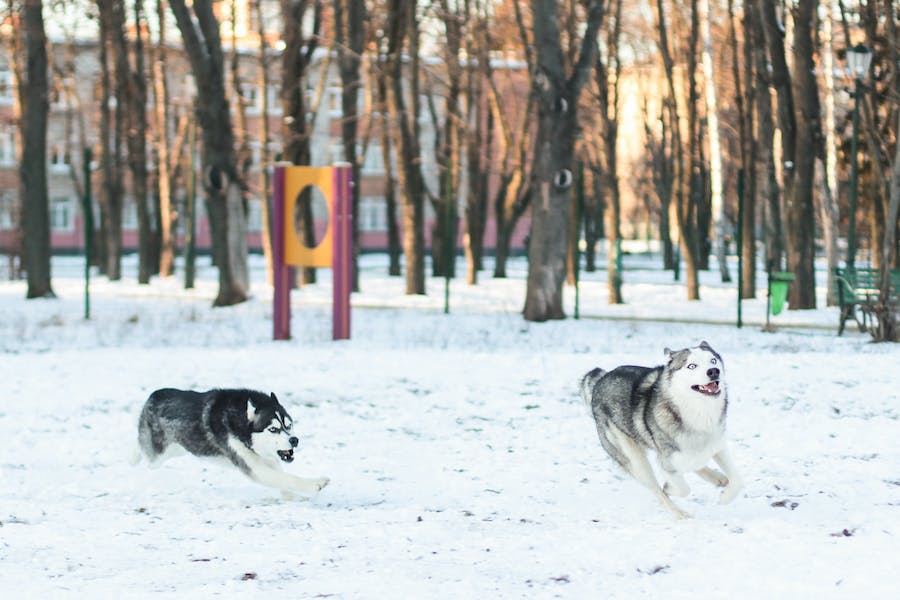With their striking appearance and vibrant energy, Huskies are more than just delightful companions; they blend intelligence, independence, and playfulness. However, these same traits can pose unique challenges in discipline and training. Renowned for their strong-willed nature and boundless energy, huskies require a unique approach to discipline that balances firmness with understanding. This article delves into effective strategies explicitly tailored for huskies, aiming to guide you through the journey of nurturing a well-behaved and happy canine companion. From understanding their distinct personality to implementing consistent training techniques, we will explore the discipline’s critical aspects that resonate with huskies’ spirited nature.
How To Discipline A Husky?
Disciplining a Husky, a breed known for its intelligence and independence, requires a unique approach that combines firmness, consistency, and understanding. Here’s a detailed explanation with critical points:
Understand the Husky’s Personality: Recognize that Huskies are intelligent, energetic, and often independent-minded. They can be stubborn and require an owner who understands these traits. Knowing your Husky’s personality is crucial for effective discipline.
Establish Leadership: Huskies respond well to a confident leader. You should establish yourself as the pack leader calmly and assertively. This doesn’t mean being harsh or aggressive; it’s about showing consistent and fair leadership.
Use Positive Reinforcement: Reward good behavior with treats, praise, or playtime. Positive reinforcement is far more effective with Huskies than punitive measures. They respond well to incentives and are likelier to repeat a behavior when it’s positively reinforced.
Consistent Training Routines: Regular training sessions are important. Consistency in commands and your responses to their behavior helps Huskies understand what is expected of them. Changing rules or being inconsistent can clarify them and lead to behavioral issues.
Set Clear Boundaries and Rules: From the outset, establish rules about what is and isn’t acceptable. This might include not jumping on furniture or specific areas where they can or cannot go. Enforce these rules consistently.
Exercise and Mental Stimulation: Huskies have high energy levels and need ample exercise. A well-exercised Husky is more likely to be well-behaved. Mental stimulation, through games and training exercises, also helps keep their mind engaged and prevents boredom, a common cause of misbehavior.
Socialization: Socializing your Husky from an early age can significantly impact their behavior. Well-socialized Huskies are less likely to exhibit aggressive or fearful behavior towards other dogs and people.
Avoid Punishment: Physical punishment or harsh scolding can be detrimental and often leads to more behavioral problems. Instead, redirect unwanted behavior towards a more acceptable action.
Why Is It Important To Understand Husky Behavior For Effective Discipline?
Understanding Husky behavior is crucial for effective discipline because it helps tailor training to their specific traits and needs. Huskies are not just any dog breed; they possess a unique blend of characteristics that require a specialized approach:
Huskies are highly intelligent, which means they can learn quickly, but their independent nature might make them seem stubborn or uninterested in following commands. Understanding this allows you to devise training strategies that challenge their minds and respect their autonomy.
Huskies have abundant energy and need regular, vigorous exercise. Recognizing their need for activity is essential in preventing behavioral issues. A bored or under-exercised Husky can develop destructive habits as an outlet for their energy.
Initially bred for pulling sleds and surviving in harsh environments, Huskies have a strong prey drive. Understanding this instinctual behavior is important for managing their interactions with other animals and during outdoor activities.
Huskies are pack animals and thrive on companionship with humans or other dogs. This social nature influences their behavior and training needs. They respond better to training that involves social interaction and may suffer from separation anxiety if left alone for too long.
Huskies communicate through a variety of vocalizations and body language. Understanding these cues helps recognize their needs and moods, which is crucial for effective discipline and building a solid bond.
What Are The Most Effective Training Techniques For Huskies?
Training a Husky effectively requires understanding their unique personality and adapting your methods accordingly. Huskies are intelligent, energetic, and sometimes willful, which calls for specific training techniques:
- Positive Reinforcement: This is the most effective technique for training Huskies. They respond well to rewards such as treats, praise, and play. Positive reinforcement encourages them to repeat desired behaviors and fosters a positive association with training.
- Consistency: Consistency in commands and rules is critical. Huskies can become confused if family members use different commands or rules are not consistently enforced. Consistent training helps them understand what is expected of them.
- Short and Engaging Training Sessions: Huskies have short attention spans but are very intelligent. Keep training sessions for about 5 to 10 minutes to maintain their interest. Incorporate games and fun activities to make learning enjoyable.
- Exercise and Mental Stimulation: It’s a good idea to exercise your Husky before training sessions. A well-exercised Husky with expended energy is more likely to focus during training. Additionally, mental stimulation through training exercises or puzzle toys helps keep their mind sharp.
- Voice Control and Body Language: Huskies are sensitive to tone of voice and body language. Use a firm, calm voice for commands and a cheerful tone for praise. Your body language should also reflect confidence and calmness.
- Socialization Training: Expose your Husky to various environments, people, and other animals from an early age. This helps develop a well-rounded, friendly, comfortable dog in different situations.
- Leash Training: Huskies have a strong prey drive and may tend to pull on the leash. Training them to walk nicely on a leash is essential. Use harnesses and leashes designed for training, and reward them for maintaining a loose leash.
- Crate Training: This can be an effective tool in house training and creating a haven for your Husky. Crate training should be done gradually and positively to ensure the Husky views the crate as a comfortable, secure place.
How Important Are Socialization And Exercise In The Discipline And Training Of A Husky?
Socialization and exercise are critically important in the discipline and training of a Husky for several reasons:
Prevention of Behavioral Problems:
Huskies are a high-energy breed, and without sufficient exercise, they can develop behavioral problems such as excessive chewing, digging, and barking. Regular exercise helps to channel their energy positively and keeps them mentally and physically healthy.
Building Confidence and Reducing Fear:
Socialization exposes a Husky to various people, animals, environments, and experiences. This exposure is crucial in their early life stages to help them become well-adjusted adults. Proper socialization reduces fearfulness and anxiety in unfamiliar situations and helps prevent aggression.
Enhancing Trainability:
Exercise and socialization can significantly enhance a Husky’s trainability. A well-exercised Husky is more likely to be attentive and responsive during training sessions. Mental stimulation through social interactions also contributes to their overall cognitive development.
Strengthening the Human-Dog Bond:
Engaging in activities together, like walking, running, or playing, strengthens the bond between you and your Husky. This strong bond is essential for practical training, as it builds trust and respect, making your Husky more inclined to follow your lead.
Managing Prey Drive:
Huskies have a natural prey drive, and socialization helps them learn appropriate behaviors around other animals. Without proper socialization, a Husky might exhibit vital chasing behaviors, which can be challenging to manage.
Fulfilling Breed-Specific Needs:
Huskies were bred as sled dogs, requiring teamwork and cooperation with other dogs and humans. Exercise and socialization fulfill these breed-specific needs, providing them a sense of purpose and well-being.
Conclusion
successfully disciplining and training a Husky requires a multifaceted approach that acknowledges their unique breed characteristics. Understanding their intelligence, energy, and independence is crucial for practical training. Techniques like positive reinforcement, consistency, and patience are vital in guiding their behavior positively. Additionally, the roles of exercise and socialization cannot be overstated; they are essential for maintaining the mental and physical well-being of a Husky, preventing behavioral issues, and strengthening the bond between dog and owner. Remember, each Husky is an individual with its personality and needs. Tailoring your approach to your specific dog will lead to a more harmonious and rewarding relationship. With the right approach and understanding, disciplining a Husky can be a fulfilling and enjoyable journey, leading to a well-behaved, happy canine companion who is a joy to be around.







Leave a Reply